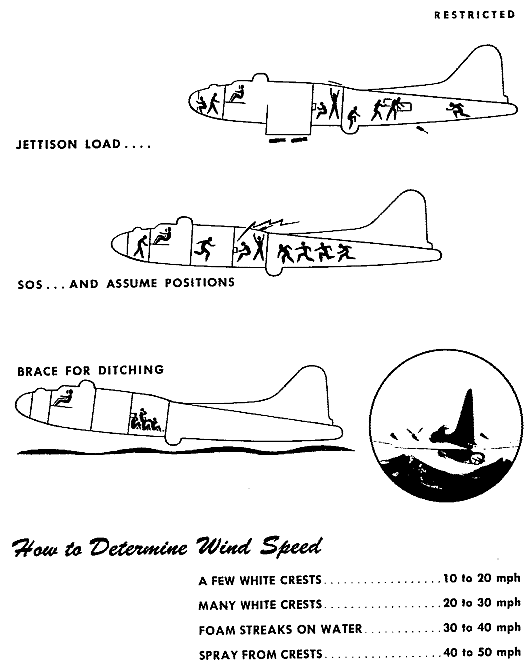Duties and Responsibilities of the Engineer
Size up the man who is to be your engineer. This man is supposed to know more about the airplane you are to fly than any other member of the crew.
He has been trained in the Air Forces' highly specialized technical schools. Probably he has served some time as a crew chief. Nevertheless, there may be some inevitable blank spots in his training which you, as a pilot and airplane commander, may be able to fill in.
Think back on your own training. In many courses of instruction, you had a lot of things thrown at you from right and left. You had to concentrate on how to fly; and where your equipment was concerned you learned to rely more and more on the enlisted personnel, particularly the crew chief and the engineer, to advise you about things that were not taught to you because of lack of time and the arrangement of the training program.
Both pilot and engineer have a responsibility to work closely together to supplement and fill in the blank spots in each other's education. To be a qualified combat engineer a man must know his airplane, his engines, and his armament equipment thoroughly. This is a big responsibility: the lives of the entire crew, the safety of the equipment, the success of the mission depend upon it squarely.
He must work closely with the copilot, checking engine operation, fuel consumption, and the operation of all equipment. He must be able to work with the bombardier, and know how to cock, lock, and load the bomb racks. It is up to you, the airplane commander, to see that he is familiar with these duties, and, if he is hazy concerning them, to have the bombardier give him special help and instruction.
He must be thoroughly familiar with the armament equipment, and know how to strip, clean, and re-assemble the guns.
He should have a general knowledge of radio equipment, and be able to assist in tuning transmitters and receivers.
Your engineer should be your chief source of information concerning the airplane. He should know more about the equipment than any other crew member -- yourself included.
You, in turn, are his source of information concerning flying. Bear this in mind in all your discussions with the engineer. The more complete you can make his knowledge of the reasons behind every function of the equipment, the more valuable he will be as a member of the crew. Who knows? Someday that little bit of extra knowledge in the engineer's mind may save the day in some emergency.
Generally, in emergencies, the engineer will be the man to whom you turn first. Build up his pride, his confidence, his knowledge. Know him personally; check on the extent of his knowledge. Make him a man upon whom you can rely.
How to Ditch the B-17
Ditching [landing on water] drill is the responsibility of the pilot. Duties should be studied, altered if necessary to agree with any modifications, memorized, and practiced until each member of the crew performs them instinctively.
The pilot's warning to prepare for ditching should be acknowledged by the crew in the order given here -- copilot, navigator, bombardier, flight engineer, radio operator, ball turret gunner, right waist gunner, left waist gunner, and tail gunner, i.e., "Copilot ditching," "Navigator ditching," etc.
Upon acknowledgment crew members remove parachutes, loosen shirt collars and remove ties and oxygen masks unless above 12,000 feet. When preparations for ditching are begun above 12,000 feet, main oxygen supply or emergency oxygen bottle is used until notification by the pilot. All crew members wearing winter flying boots should remove them. No other clothing should be removed.
Releases on life rafts should not be pulled until the plane comes to rest.
Beware of puncturing rafts on wing and horizontal surfaces after launching. The dinghies should be tied together as soon as possible.
Injured men should get first consideration when leaving the airplane.
Life vests should not be inflated inside the plane unless the crew member is certain that the escape hatch through which he will exit is large enough to accommodate him with the vest inflated.
When personnel are in dinghy, stock of rations and equipment should be taken by the airplane commander (or copilot). Strict rationing must be maintained. Flares should be used sparingly and only if there is a reasonable chance that they will be seen by ships or aircraft. Don't forget the Very pistol.
Lash the life rafts together.
Landing crosswind is recommended unless the wind exceeds about 30 mph, in which case land into the wind. In executing the crosswind landing, the pilot will line up with the lines of the crests, at any convenient altitude, adjust flaps, power settings, trim, and make the approach with a minimum rate of descent, with a minimum forward speed. Land on a crest parallel to the line of crests or troughs. Crabbing will be necessary to remain over the crest while making the approach.
Flight Engineer
- Jettisons ammunition and loose equipment, turns top turret guns to depressed position pointing forward.
- Goes to radio compartment. Lowers the radio hatch and moves it to the rear of the plane, jettisons loose equipment in radio compartment, and slides back top gun.
- Stands with back to aft door of radio compartment and assists other members out by boosting them.
- Last man to leave radio compartment, with bombardier's help. Goes to left dinghy.
